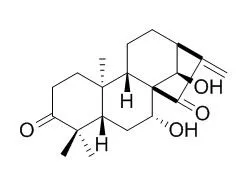| In vitro: |
| Acta Biochim Biophys Sin (Shanghai). 2013 Nov;45(11):946-52. | | Glaucocalyxin A, a negative Akt regulator, specifically induces apoptosis in human brain glioblastoma U87MG cells.[Pubmed: 24041957] | Akt is becoming an attractive target in the development of anti-tumor agents. In the present study, we aimed to discover novel negative Akt regulators against malignant glioma.
METHODS AND RESULTS:
An Akt regulator screening platform performed in an Akt-GFP overexpression cell line was developed, and natural product library was screened and evaluated using this platform. In addition, the cytotoxic effect of the regulator was detected by MTT assay. Cell apoptosis was assayed by Hoechst 33342 staining and flow cytometry analysis. Afterwards, the apoptotic signaling pathway was investigated by western blot analysis. Glaucocalyxin A, isolated from Rabdosia japonica, was identified as a potent negative regulator of Akt. In human-derived malignant glioma U87MG cells, Glaucocalyxin A inhibited Akt phosphorylation, suppressed proliferation, and promoted apoptosis in a dose-dependent manner, but not in normal glial cells. Furthermore, Glaucocalyxin A activated caspase-3, decreased BAD phosphorylation, and reduced the expression of X-linked inhibitor of apoptosis protein.
CONCLUSIONS:
Taken together, these results indicated that Glaucocalyxin A may become a promising candidate in the treatment of malignant glioma. | | Eur J Med Chem. 2014 Oct 30;86:235-41. | | Synthesis and biological evaluation of glaucocalyxin A derivatives as potential anticancer agents.[Pubmed: 25164762] | A series of Mannich base type derivatives of Glaucocalyxin A (GLA) were designed and prepared.
METHODS AND RESULTS:
The cytotoxicity of these compounds was evaluated against six tumor cell lines (SMMC-7721, B16, SGC-7901, A549, KB, HL-60). Most compounds exhibited potent antiproliferative effects with low micromolar IC50 values. Compound 1 with para methyl benzyl amine moiety and compound 16 with cyclohexylamine moiety displayed the highest inhibition efficacy. Significantly, the cytotoxicity of compound 1 was much lower than GLA against the normal human liver cell (HL-7702). The in vitro stability assay revealed that transformation of GLA to Mannich base type derivatives improved the compound stability in rat plasma. Finally, decomposition product analysis supported that compound 1 could act as a prodrug and release GLA in the intracellular environment. | | PLoS One. 2013 Dec 30;8(12):e85120. | | Glaucocalyxin A inhibits platelet activation and thrombus formation preferentially via GPVI signaling pathway.[Pubmed: 24386454] | A series of Mannich base type derivatives of Glaucocalyxin A (GLA) were designed and prepared.
METHODS AND RESULTS:
The cytotoxicity of these compounds was evaluated against six tumor cell lines (SMMC-7721, B16, SGC-7901, A549, KB, HL-60). Most compounds exhibited potent antiproliferative effects with low micromolar IC50 values. Compound 1 with para methyl benzyl amine moiety and compound 16 with cyclohexylamine moiety displayed the highest inhibition efficacy. Significantly, the cytotoxicity of compound 1 was much lower than GLA against the normal human liver cell (HL-7702).
CONCLUSIONS:
The in vitro stability assay revealed that transformation of GLA to Mannich base type derivatives improved the compound stability in rat plasma. Finally, decomposition product analysis supported that compound 1 could act as a prodrug and release GLA in the intracellular environment. | | Thromb Haemost. 1992 Apr 2;67(4):458-60. | | Inhibition by glaucocalyxin A of aggregation of rabbit platelets induced by ADP, arachidonic acid and platelet-activating factor, and inhibition of [3H]-PAF binding.[Pubmed: 1631795] | Glaucocalyxin A is a new diterpenoid isolated from the ethereal extract of the leaves of Rabdosia japonica (Burm f) Hara var glaucocalyx (Maxim) Hara (Labiatae) collected in the northeastern China.
METHODS AND RESULTS:
When it was incubated with washed rabbit platelets, Glaucocalyxin A inhibited ADP- or arachidonic acid-induced platelet aggregation with IC50 values of 4.4 mumol/l, 14.1 mumol/l respectively. Glaucocalyxin A also inhibited PAF-induced aggregation of rabbit platelets which were refractory to ADP and arachidonic acid with an IC50 value of 13.7 mumol/l.
CONCLUSIONS:
Analysis of [3H]-PAF binding showed that Glaucocalyxin A prevented [3H]-PAF binding to intact washed rabbit platelets with an IC50 value of 8.16 mumol/l, which was consistent with its inhibition of PAF-induced platelet aggregation. |
|






 Cell. 2018 Jan 11;172(1-2):249-261.e12. doi: 10.1016/j.cell.2017.12.019.IF=36.216(2019)
Cell. 2018 Jan 11;172(1-2):249-261.e12. doi: 10.1016/j.cell.2017.12.019.IF=36.216(2019) Cell Metab. 2020 Mar 3;31(3):534-548.e5. doi: 10.1016/j.cmet.2020.01.002.IF=22.415(2019)
Cell Metab. 2020 Mar 3;31(3):534-548.e5. doi: 10.1016/j.cmet.2020.01.002.IF=22.415(2019) Mol Cell. 2017 Nov 16;68(4):673-685.e6. doi: 10.1016/j.molcel.2017.10.022.IF=14.548(2019)
Mol Cell. 2017 Nov 16;68(4):673-685.e6. doi: 10.1016/j.molcel.2017.10.022.IF=14.548(2019)